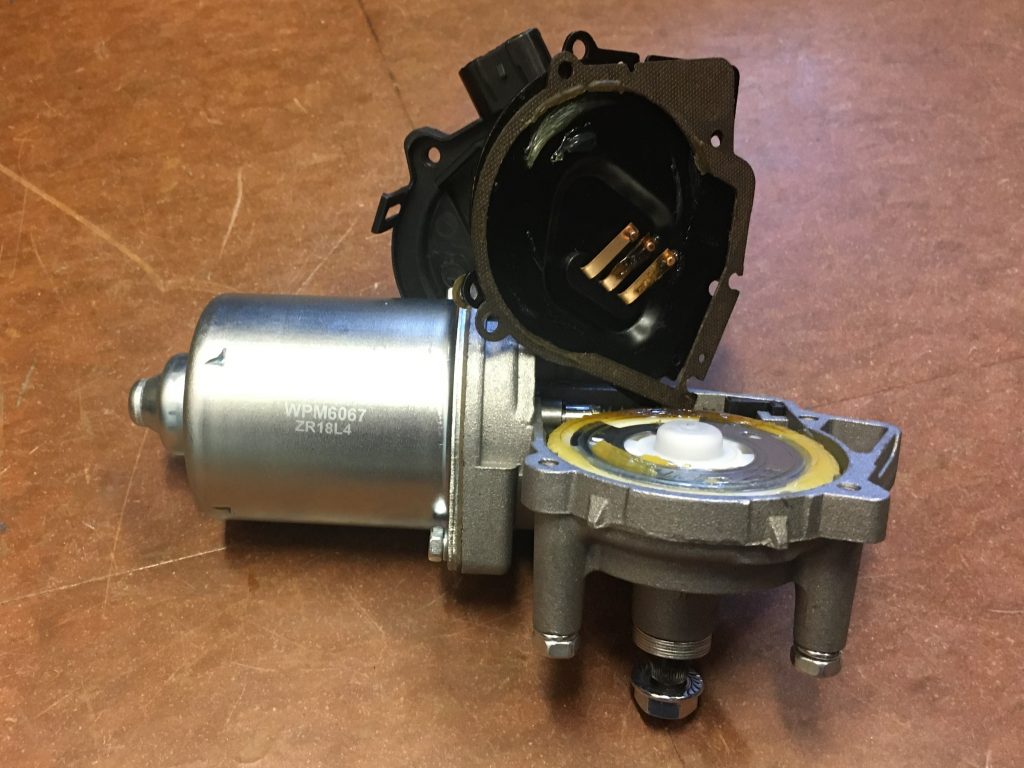Updated 15 April 2020
This page describes our best information to date regarding selecting motors.
Motor & Encoder
The mechanical system should be driven with a motor under closed loop control. For feedback measurement, we are using a DC gear motor with integrated quadrature feedback.
Prototype component: Andy Mark AM 3656 188:1 gearmotor with encoder. This was scavenged from a FIRST Robotics kit and we are using it in test applications. This is provided as an example, builders must use their supply chain to identify correct motors for their application.
Motor Options: Brushed DC motor with gearbox and position feedback. Any sufficiently high-torque, back-driveable motor with angle sensing, integrated or separated, should work.
Note: The motor and mechanism, together, must be back drivable in order to move the mechanism by hand, remove the bag and immediately convert to manual bagging. It is not ideal to back drive gear motors, but this is primarily for use in a fault condition.
Stepper Motors? – hard
Stepper motors are best suited for precision motion control where the motion profile can be well defined, the load is constant and disturbances are limited. Industrial motion control and 3D printers are good examples.
Patients present a very different scenario where the load on the motor changes dynamically over short and long terms. With each breath the motor faces increasing resistance as the balloon (the patient) is inflated. Over time the patient’s airway resistance and lung compliance can also change. There is no straightforward way to close a PID loop around a stepper; fundamentally it is designed to run open loop. More complicated control strategies can be employed.
Caution – If a stepper motor is used, position must be taken from an angle sensor so that missed steps do not cause position drift and failures to reach desired tidal volume are not detected and responded to.
Operating Parameters
Understanding the best way to care for COVID-19 patients is changing daily.
These are our best, current working specifications. Be sure to apply your own safety factors, recommended 2x.
In advance, we apologise profusely to our international colleagues for using English units and gears. It’s hard to undo this decision at this point.
Assumed nominal operating parameters: Referencing the most recent clinical documentation of max 40 breath-per-minute (bpm), up to a 1:4 I:E ratio and a pop off set to 40 H2O, our Unit 003 Design consists of:
- From Power Calculation we estimated 10 N-m of torque required by each finger. Doubling this yields 20 N-m for the gripper. As described in Mechanical our Version 3 has a 1.6 (48/30 teeth) gear ratio yielding a desired motor torque of 12.5 N-m, which we round up to 15 N-m.
- Arm: Approximately 30° back and forth
- Two week operation minimum: approximately 1 million cycles, 100% duty.
- Quadrature encoder integrated (ours provides 7 pulses / rev of motor shaft). This is integrated with the base of the motor so that it does not respond to any backlash in the system.
- The radial force on the gearbox shaft is estimated at 530 N, as described in Mechanical. This is applied by the pinion approximately 1 cm from the face of the gearbox; thus bending on the output shaft must also be considered.
- We have created a Gear Torque and Speed Estimator Spreadsheet, available in Downloads.
Caution: In deployed use, the motor must be able to operate continuously for several days, 100% duty cycle. This may require larger motors than expected or increased motor cooling to prevent overheating.
For photos of our motor and attachment see Mechanical Design.
Windshield wiper motors? – maybe
We have investigated windshield wiper motors and they are NOT back-drivable, due to the worm drive, they lack integrated position sensing, nor can they necessarily take the shaft loads resulting from gear separation forces. People with access to automotive tier suppliers may be able to access better information.
Windshield wiper motors vary greatly in their specifications, so we cannot make general recommendations. If they are to be used, a mechanical arm release should be incorporated so that a bag can be instantly removed to facilitate instant conversion to manual bagging. The larger issue is the lack of position sensing – without this volume control is not feasible nor is safe ventilation even possible. Mechanical cams have been suggested, but they do not enable sufficient control of respiratory parameters to have any useful therapeutic effect. Encoders and potentiometers (POTs) can be used, but they should only be implemented by someone with experience in feedback control. They are a potential solution.
Shown below is a Toyota replacement wiper motor. From inspection we can see that it employs a tapered spline, with limited area for more traditional connections. While there are limit switches (three contactors) there is no accurate position feedback. From inspection of other models, bolt patterns, dimensions and connections vary widely. We hesitate to make any specific recommendations.


Recent Comments